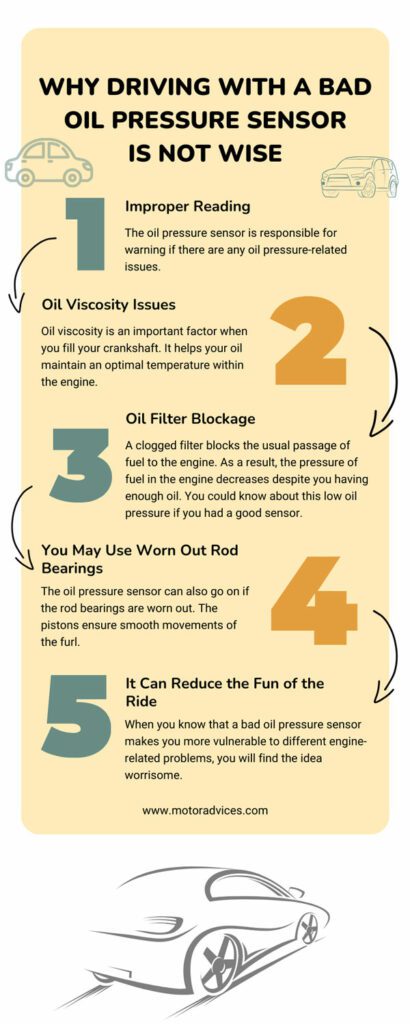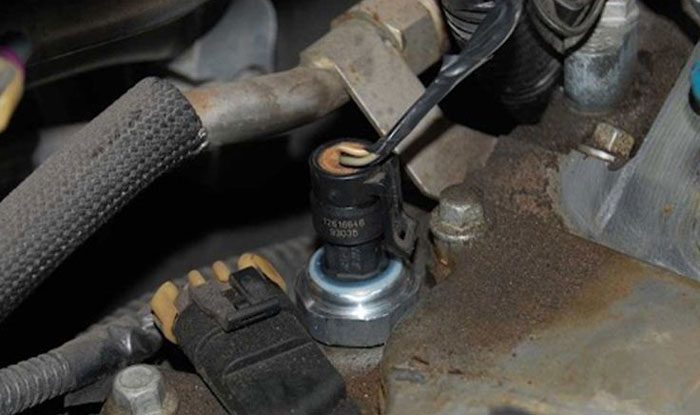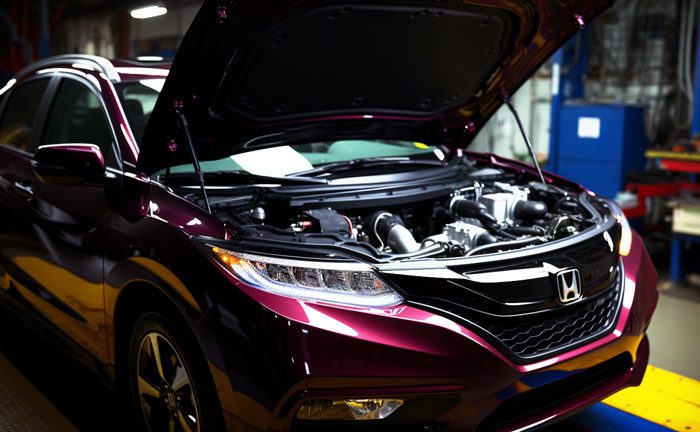Is Driving With Bad Oil Pressure Sensors Safe? 5 Reasons Why It Is Not
A bad oil pressure sensor will not give you the right reading of the engine oil, which is vital for your safety. The pressure switch can go bad for many reasons. But sometimes, you might need to drive even when the sensor is not working.
Will it be safe to drive with bad oil pressure sensors? In general, it is not wise to drive your car with a bad sensor or any other malfunctioning components. A good sensor could warn you about oil leaks, worn bearings, faulty oil pumps, bad fuel, and more. You are going to miss all these signals, and any of them can lead to severe engine damage.
Many people still drive with bad sensors. Let’s find out the risks so that you know the importance of changing a bad sensor.
Why Driving With a Bad Oil Pressure Sensor Is Not Wise
The purpose of the oil pressure sensor is to warn you if there is not sufficient pressure in the engine. Driving with a bad pressure sensor poses the following risks.

Improper Reading
The oil pressure sensor is responsible for warning if there are any oil pressure-related issues. Since your sensor is not working properly, you will not get the correct reading.
As a result, if the car oil pressure is low, it may go unnoticed. Driving your car with low oil pressure can even destroy the engine, and you will end up spending a good sum of money repairing or replacing it. You may use the car in low oil, which can cause problems in gear shifting.

Oil Viscosity Issues
Oil viscosity is an important factor when you fill your crankshaft. It helps your oil maintain an optimal temperature within the engine. Besides, viscosity is also related to oil pressure. The viscosity of oil affects its ability to maintain proper oil pressure within the engine.
Using the wrong viscosity oil can lead to inadequate lubrication, increased friction, and overheating in the engine. The oil pressure sensor can give indications if you’ve used the wrong viscosity oil.
If you have a bad pressure switch, then it is unlikely that you will realize that you have used the wrong oil. Ultimately, you will be subjected to some severe engine damage.

Oil Filter Blockage
A clogged filter blocks the usual passage of fuel to the engine. As a result, the pressure of fuel in the engine decreases despite you having enough oil. You could know about this low oil pressure if you had a good sensor.
When you drive with a bad one, such problems will go unnoticed as you will not bother checking the filter after seeing enough oil in the engine.
You May Use Worn Out Rod Bearings
The oil pressure sensor can also go on if the rod bearings are worn out. The pistons ensure smooth movements of the furl. Oil escapes the rod-bearing channels faster when they are worn out. Therefore, the pressure gets lower. Again, you will miss the hint because of a bad pressure switch and end up with more difficult problems.
It Can Reduce the Fun of the Ride
When you know that a bad oil pressure sensor makes you more vulnerable to different engine-related problems, you will find the idea worrisome. You will have to be extra careful during the drive. This can affect the fun of the ride.
Symptoms of a Bad Oil Pressure Sensor

A bad oil pressure sensor will give you some hints. Being mindful of these signs will help you avoid further damage.
- Inaccurate reading is the primary symptom of a bad oil pressure sensor. It will indicate that you may be out of fuel despite having enough oil.
- There will be frequent appearances and disappearances of the oil light.
- You will have difficulty starting the car. The ECU will not permit the engine to start because of the faulty signals by the oil pressure sensor.
- The check engine light can come on as well to hint that some part of the engine is not working properly.
How Do You Check If The Oil Pressure Sensor Is Bad?

If you experience the above-mentioned symptoms, you should check whether your oil pressure sensor is faulty. Here is how you can be sure of the sensor problem.
Use an Oil Pressure Gauge
Connecting a gauge to the sensor port is an ideal method to ensure that the reading of the sensor is accurate. In some cases, you may need to use an adapter to install the gauge with the sensor. If the gauge shows a different level than the sensor, then your sensor is faulty.
Check the Oil Level
If you notice the oil pressure sensor is blinking, then you should check on the engine oil level. If you have enough oil and the light is still blinking, then the sensor is probably bad. You must also check the quality of the oil you use. You can use oil level by using a dipstick. Watch this video to see how to do this.
How to Drive Safely When the Oil Pressure Sensor Is Not Working?
You can ignore a bad oil pressure sensor. In fact, many people drive with a bad sensor for months. And you will hear them claiming not facing any problem. Nonetheless, you should avoid this practice as it can be dangerous for both you and your vehicle.

In case you are in urgent need of driving your car with a bad sensor, then you should maintain these tips:
- Check the engine and other components properly to ensure there is no oil leakage. Check the place where the car was parked.
- Measure the oil level on the dipstick to ensure you have enough oil to maintain optimal oil pressure.
- If you notice any unusual burning smell or noise from the engine, you should immediately check on the engine.
- Before going on a long drive, check the oil filter. Cleaning it will be a safer precaution to avoid clogging.
- Make a list of the reasons why an oil pressure sensor lights up. Check all the related components, like the oil pump, rod bearings, oil viscosity, etc., to ensure the oil pressure will remain static and good during your trip.
How to Change the Oil Pressure Sensor?
Changing the sensor is not too challenging to do it yourself. Here is how to do it:
- Lift the car using a jack, as it will make working easier for you.
- Take help from the user manual to locate the oil pressure sensor.
- Disconnect the electrical connector from the sensor and remove it with a wrench
- Apply thread sealant to the new sensor’s threads to prevent oil leaks.
- Install the new sensor and tighten it securely.
- Start the engine and check for leaks. No leakage of oil ensures you did it in the right way.
You need to be careful of these steps while changing the sensor. Watch this video for visual support:
FAQs
The questions below will help you gain more insights on the topic of running a car with a bad oil pressure switch.
Yes, the oil pressure sensor plays a crucial role in engine performance. It monitors oil pressure and confirms you have proper lubrication. A malfunctioning sensor may lead to inadequate lubrication, which can cause reduced engine performance and damage as well.
Yes, a faulty oil pressure sensor can affect the transmission. The failure of proper detection of low oil pressure by the sensor can lead to insufficient lubrication in the engine, and you may face difficulties in switching gears.
A bad oil pressure sensor is unlikely to cause braking problems directly. Braking issues are related to the brake system, such as brake fluid levels or brake components. Oil pressure sensors are designed to alert you of the oil pressure in the engine.
Conclusion
It is not safe to drive with bad oil pressure sensors as you will miss many faulty components’ alerts. Some of the issues can lead to bigger problems and even cause engine failure. Therefore, you must not ignore a malfunctioning oil pressure switch.
Changing the switch is too challenging to be done by yourself. Follow the above-mentioned instructions and enjoy your ride without any fear.

